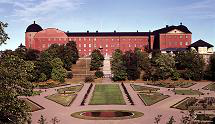Sprecher
Prof.
Alexander Glushkov
(Odessa University -OSENU)
Beschreibung
A relativistic operator approach, based on the unified operator perturbation theory and relativistic energy formalism [1], is applied for studying resonant phenomena in the low-energy heavy-nuclei collisions accompanying the electron-positron pair production (EPPP) process and treating the compound nucleus in an extreme electromagnetic (electric) field. As it is known, a narrow e+ line in the positron spectra obtained from heavy ions collisions near the Coulomb barrier is existed (see, e.g.,[1,2]). In our approach the positron spectrum narrow peaks as a spectrum of the resonance states of compound super heavy nucleus are treated. Resonance phenomena in the nuclear system lead to structurization of the positron spectrum produced. To calculate the EPPP cross-section we used the modified versions of the relativistic energy approach, based on the S-matrix Gell-Mann and Low formalism [1]. The nuclear and electron subsystems are considered as two parts of the complicated system, interacting with each other through the model potential. The nuclear system dynamics is treated within the Dirac equation with an effective potential. All the spontaneous decay or the new particle (particles) production processes are excluded in the 0th order. The calculation results for cross-sections at different collision energies (non-resonant energies and resonant ones), corresponding to energies of resonances of the compound 238U+238U, 232Th+250Cf and 238U+248Cm nuclei are presented. Calculation with the different nuclear potentials is carried out and shows principally the same physical picture, however using the two-pocket nuclear potential in comparison with the one-pocket one [2] leads to an appearance of a few new peaks. At last, we generalize a developed approach to describe relatively low-energy collision of the heavy ion with light projectiles (proton, antiproton).
References
1. A.V.Glushkov, Low Energy Antiproton Phys. (AIP). 2005. V.796.P.206; J.Phys.: CS. 2012. V.397. P.012011; Quantum Systems in Chemistry and physics, Progress in Methods and Applications, Eds. K. Nishikawa et al (Speinger). 2013. V. 26. P.231; A.V.Glushkov et al, Nucl.Phys.A. 2004. V.734S, 21; Int. J. Mod. Phys.A. Nucl.Phys. 2009. V. 24. P.611.
2.P. Kienle, Phys.Scripta. 1993. V.T46. P.81; J.Reinhardt, U.Muller, W.Greiner, Z.Phys.A.1981.V.A303.P.173; V.Zagrebaev, W.Greiner, J. Phys. G. 2007.V.34.P.1; 2002. V.31.P.825.
Summary
Resonant phenomena in the low-energy heavy-nuclei collisions accompanying the electron-positron pair production process and treating the compound nucleus in an extreme electromagnetic (electric) field are quantitatively (compound 238U+238U, 232Th+250Cf and 238U+248Cm nuclei) studied within the combined operator perturbation theory and relativistic energy formalism. An approach is generalized to describe low-energy collision of the heavy ion with light projectiles (proton, antiproton) too.
Autor
Prof.
Alexander Glushkov
(Odessa University -OSENU)

